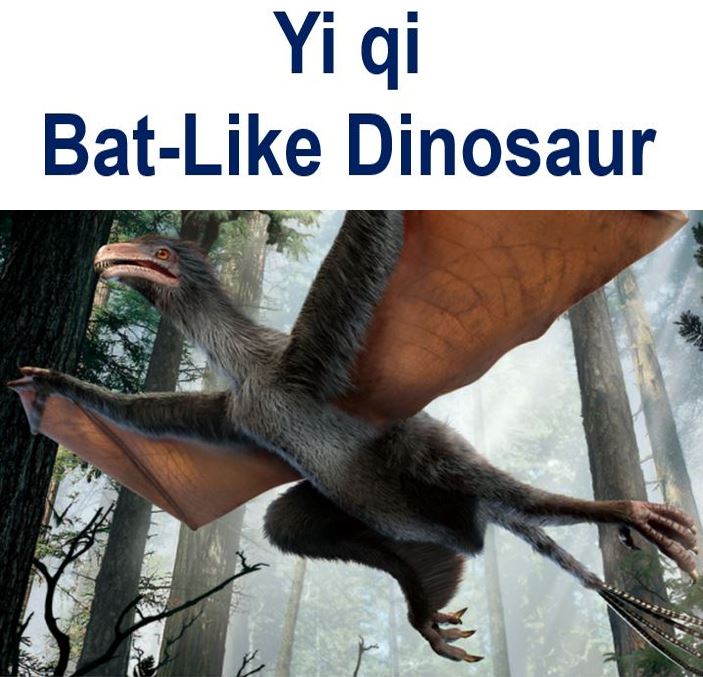The fossil of a small, feathered dinosaur, about the size of a magpie with bat-like wings, has been discovered in the Hebei Province in China. Scientists from Beijing’s Chinese Academy of Sciences say the discovery adds another piece to the evolution of flight puzzle.
The small creature, which existed about 160 million years ago, appears to belong to a previously unknown species of obscure mini dinosaurs – Scansoriopterygids – and may have been related to the famous primitive bird, Archaeopteryx.
The new discovery, named Yi Qi, which means Strange Wing, is probably not related to the origin of mammalian bats, the scientists say. They believe it is an example of convergent evolution – when different species evolve with similar features, such as developing a prominent bone on their hand or wrist.

An artist’s impression of the small, bat-like dinosaur ‘Yi qi’. (Image: Nature)
Perhaps it flew or glided
The scientists, who wrote about their discovery in the academic journal Nature (citation below), said the small feathered creature might have been able to fly or glide short distances.
It has a 13-centimetre-long rod-like bone that extends from each wrist, which probably helped to support or position wing membranes. There are also small patches of membranous tissue clinging around the bones.
This is the first time such a bone structure has been seen in dinosaurs.
Lead author, Xing Xu, a palaeontologist at the Institute of Vertebrate Paleontology and Paleoanthropology in Beijing, said it is hard to determine how much area of the dinosaur’s wing the membranes covered.
Xu and colleagues believe the creature weight about 380 grams and had a 60-centimetre wingspan – about the size of a magpie, but slightly heavier.
Sid Perkins, writing in Nature News, quoted Thomas Holtz Jr, a vertebrate palaeontologist at the University of Maryland in College Park, who said:
“This is one of the strangest animals that I’ve seen in the fossil record in years. It’s raising a lot more puzzles than it’s solving.”
Xu and team say they are uncertain whether the rod-like bone extending from the animal’s wrist stayed in one position or could somehow move to control the membrane.
With just one specimen to work with, they do not know whether Yi Qi glided, flapped its wings or did a bit of both, as do some bats today and a number of birds, including swifts, finches and woodpeckers.
Probably spent more time gliding
If it did take to the air, the team believes it probably spent most of its time gliding, rather than flapping its wings.

Scientists believe it might have been rather back-heavy and could have risked stalling in the air. (Image: Nature Video)
Features on the animal’s forelimb bones suggest its flight muscles may have been relatively weak and small, and the bone on the wing membrane may have made it difficult to flap properly.
Yi Qi’s feather would not have helped it to fly, being more like stiff frayed bristles than the aerodynamic structures modern birds have.
If it did fly, Yi Qi’s aerial skills would have evolved separately from those of pterosaurs, Holtz said.
Holtz suggested the animal’s membranes could have been display devices, used during courtship rituals. “The temptation to associate these membranes with flight may be misleading,” he said.
Citation: “A bizarre Jurassic maniraptoran theropod with preserved evidence of membranous wings,” Xing Xu, Xiaoting Zheng, Corwin Sullivan, Xiaoli Wang, Lida Xing, Yan Wang, Xiaomei Zhang, Jingmai K. O’Connor, Fucheng Zhang & Yanhong Pan. Nature. Published 29 April, 2015. DOI: 10.1038/nature14423.
Video – A new dinosaur, flying without feathers
While we know birds evolved from dinosaurs, scientists say it wasn’t a smooth transition. Several creatures tried different ways to get into the air – like this newly discovered dinosaur species, Yi qi, unearthed in China. This magpie-sized creature had elongated fingers that held a membrane wing, more like a bat than a bird.
This Nature Video looks at what makes this fossil so special, and considers what this dinosaur may have looked like.
